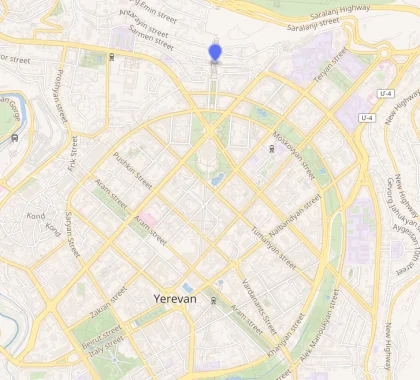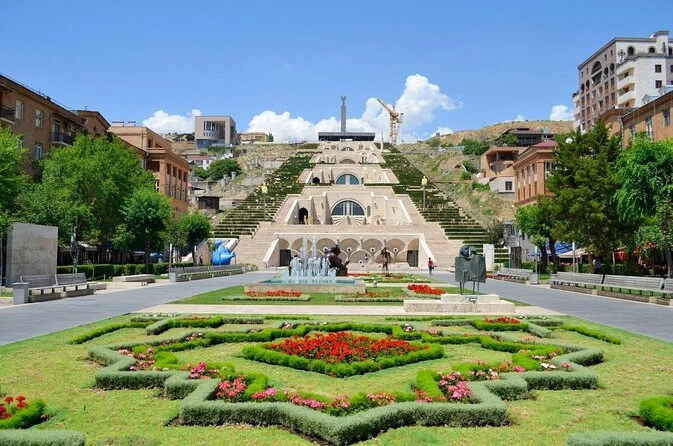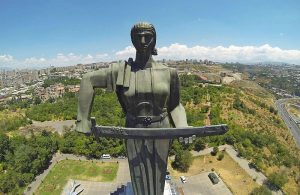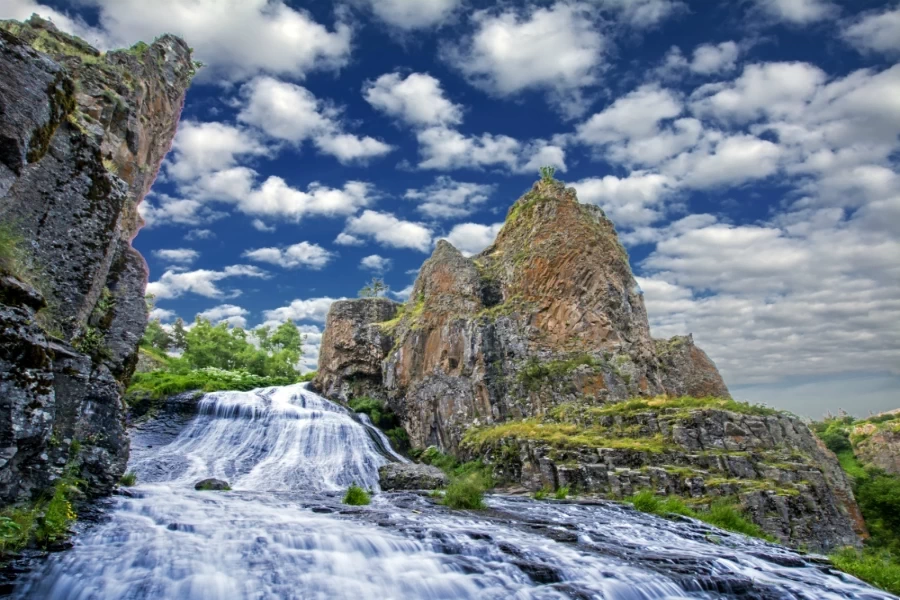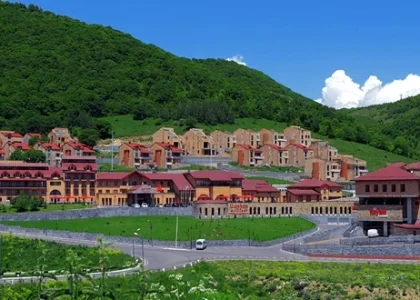The Yerevan Cascade is a monumental architectural complex located in the Armenian capital, Yerevan. Built using white travertine stone, the Cascade is situated in the northern part of the city center, near the Opera House and the Matenadaran. This structure is a legacy of Soviet-era architecture in Armenia, linking the city center with Victory Park, which commemorates the Soviet Army’s victory over Nazi Germany in World War II. The Cascade features a terrace at the top, offering panoramic views of the Ararat Valley and downtown Yerevan. It also houses the statue of “Mother Armenia,” which includes a military museum dedicated to World War II and the Nagorno-Karabakh conflict.
Structure and Design:
The Cascade comprises five terraces connected by 572 steps. The building is 302 meters tall (excluding the 118-meter Soviet Armenian 40th Anniversary Monument), 50 meters wide, and spans a total area of 13 hectares with a 15-degree incline. The upper platform, known as the “Memorial Terrace,” features the Soviet Armenian 40th Anniversary Monument. The terrace is surrounded by 15 columns that reflect Armenia’s historical heritage. Each floor and section of the exterior staircase is a unique work of art. Inside, the building has elevators and escalators connecting all platforms from the base to the top. This architectural area extends as an open park for modern art, surrounded by green spaces.
Cafesjian Center for the Arts:
The building houses the Cafesjian Center for the Arts, which includes exhibition halls for permanent and temporary exhibitions. Founded in 2009, the museum is very popular in Yerevan. It features several galleries, such as “Gallery One” (showcasing works by glass artists like Ivan Mares, Jaromir Rybak, Pavel Trnka, John Kuhn, Herb Babcock, Yan Zoricak, and Bertil Vallien), “Khachkar Gallery,” and “Eagle Gallery” (featuring works from the collections of art historian Boghos Haytayan, artist Robert Elibekian, and architect Oshin Yeghiazarian). The museum also includes the “Sassuntsi Davit Garden Gallery” (displaying glass pieces by prominent European artists like Stanislav Libensky and Jaroslava Brychtova), as well as the “Eagle Garden” and the “Swarovski Gallery.” The museum boasts over 500 artworks from the collection of its founder Gerard Cafesjian, along with works by global artists like Fernando Botero, Arshile Gorky, Lynn Chadwick, Jaume Plensa, and Barry Flanagan.
Outdoor Sculptures:
Outside the building, there is a park featuring sculptures by renowned artists such as Lynn Chadwick (British sculptor), Barry Flanagan (Welsh sculptor), Stanislav Libensky and Jaroslava Brychtova (Czech duo), Paul Cox (English sculptor), Jaume Plensa (Spanish Catalan artist and sculptor), and Fernando Botero (Colombian artist).
Statue of Alexander Tamanyan:
The Cascade also features a statue dedicated to Alexander Tamanyan, a prominent Yerevan architect, created by Artashes Hovsepyan in 1974. The statue depicts Tamanyan bent over a large tablet supported by two small stones, symbolizing the old and new periods of architecture, representing Tamanyan’s role in building modern Yerevan.
Events and Activities:
The Cafesjian Center for the Arts regularly hosts various events, including lectures, film screenings, concerts, and educational programs for all ages, attracting over a million visitors annually.
Cultural and Recreational Hub:
The Cascade is a popular meeting and entertainment spot year-round, with numerous cafes and restaurants on both sides of the complex frequented by locals and tourists. Classical and jazz concerts are held on the steps during spring, summer, and early fall, where audiences sit on the steps to enjoy the performances.
History and Construction:
The idea of creating tiered waterfalls and gardens in Yerevan was first proposed by architect Alexander Tamanyan in the 1920s, but the project was not realized during his lifetime. In 1970, the idea was revived by the city’s chief architect, Jim Torosyan, along with Sargis Gurzadyan and Aslan Mkhitaryan, with support from the Soviet government. Construction began in the 1980s but was halted due to several events, including the 1980 Moscow Olympics, the 1988 earthquake, and the collapse of the Soviet Union in 1991.
Restoration and Completion:
In 2002, the Armenian government decided to rebuild the existing parts of the Cascade and complete the unfinished sections. This project was undertaken by the Cafesjian Museum Foundation in collaboration with architect David Hudson, and the arts center opened in 2009. Gerard Cafesjian, the project’s main benefactor, donated $128 million for the restoration of the building. Plans include creating a large glass museum at the top level and two cinemas, one inside the museum, which are still under construction.
Conclusion:
The Yerevan Cascade, with its architectural brilliance and stunning views, has become one of the most attractive and visited places in Yerevan. It offers an exemplary model of architecture and continues to draw locals and tourists alike.
